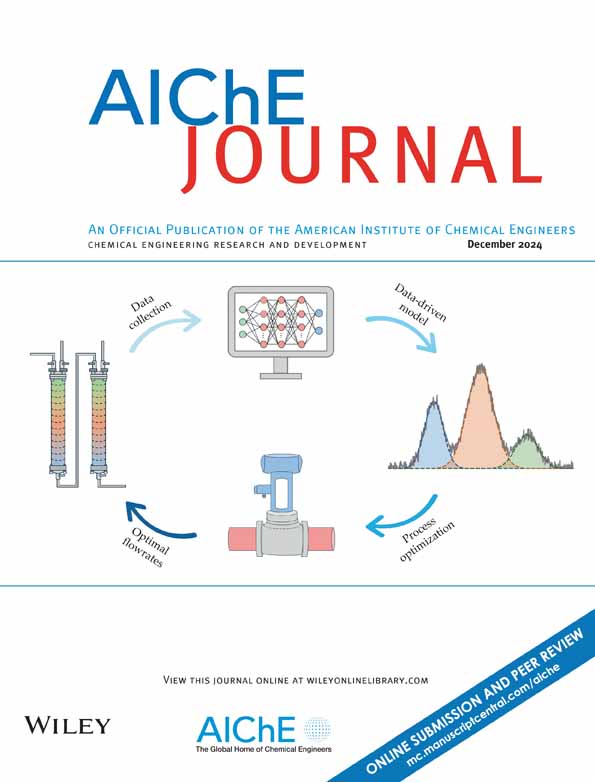Emulsion interfacial nanoarchitectonics with a biomimetic channel‐architected polymer for enhanced biocatalysis
IF 4
3区 工程技术
Q2 ENGINEERING, CHEMICAL
引用次数: 0
Abstract
Overcoming mass transfer limitations at the water–organic interface is critical in biphasic biocatalysis. Inspired by the natural cellular processes such as endocytosis and transport proteins, we developed an amphiphilic polymer with jellyfish‐like nanoarchitectonics to engineer the emulsion interface. This polymer forms dynamic micelles to compartmentalize hydrophobic compounds and creates channel‐like structures that facilitate substrate transfer across the phase boundary. Compared to the single‐chain polymer, the jellyfish‐inspired emulsifier significantly enhanced the biphasic biotransformation across diverse reactions. In the un‐emulsified systems, the channel‐structured polymer boosted the yield of the benzaldehyde lyase‐catalyzed benzoin condensation reaction by over 50% relative to controls. In the emulsified systems, a 77% higher efficiency was achieved in the multi‐enzyme cascade reaction involving aromatic and aliphatic substrates, underscoring its versatility. This work bridges the gap between polymer architecture design and biocatalytic performance, offering a biomimetic strategy to engineer emulsion interfaces for revolutionizing mass transfer in biphasic systems.乳液界面纳米结构与仿生通道结构聚合物增强生物催化
克服水-有机界面的传质限制是双相生物催化的关键。受自然细胞过程(如内吞作用和转运蛋白质)的启发,我们开发了一种具有水母状纳米结构的两亲性聚合物来设计乳液界面。这种聚合物形成动态胶束来分隔疏水化合物,并形成通道状结构,促进底物在相边界上的转移。与单链聚合物相比,水母激发乳化剂显著增强了不同反应的双相生物转化。在非乳化体系中,与对照相比,通道结构聚合物使苯甲醛裂解酶催化的苯甲酰缩合反应的产率提高了50%以上。在乳化体系中,涉及芳香族和脂肪族底物的多酶级联反应的效率提高了77%,强调了其通用性。这项工作弥合了聚合物结构设计和生物催化性能之间的差距,提供了一种仿生策略来设计乳液界面,以彻底改变双相系统的传质。
本文章由计算机程序翻译,如有差异,请以英文原文为准。
求助全文
约1分钟内获得全文
求助全文
来源期刊

AIChE Journal
工程技术-工程:化工
CiteScore
7.10
自引率
10.80%
发文量
411
审稿时长
3.6 months
期刊介绍:
The AIChE Journal is the premier research monthly in chemical engineering and related fields. This peer-reviewed and broad-based journal reports on the most important and latest technological advances in core areas of chemical engineering as well as in other relevant engineering disciplines. To keep abreast with the progressive outlook of the profession, the Journal has been expanding the scope of its editorial contents to include such fast developing areas as biotechnology, electrochemical engineering, and environmental engineering.
The AIChE Journal is indeed the global communications vehicle for the world-renowned researchers to exchange top-notch research findings with one another. Subscribing to the AIChE Journal is like having immediate access to nine topical journals in the field.
Articles are categorized according to the following topical areas:
Biomolecular Engineering, Bioengineering, Biochemicals, Biofuels, and Food
Inorganic Materials: Synthesis and Processing
Particle Technology and Fluidization
Process Systems Engineering
Reaction Engineering, Kinetics and Catalysis
Separations: Materials, Devices and Processes
Soft Materials: Synthesis, Processing and Products
Thermodynamics and Molecular-Scale Phenomena
Transport Phenomena and Fluid Mechanics.
 求助内容:
求助内容: 应助结果提醒方式:
应助结果提醒方式:


